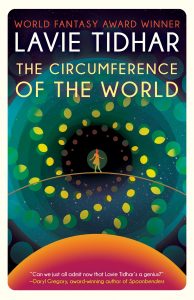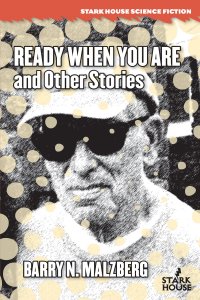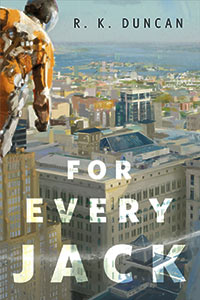Ian Mond Reviews The Circumference of the World by Lavie Tidhar
 The Circumference of the World, Lavie Tidhar (Tachyon Publications 978-1-61696-362-0, $17.95, 256pp, tp) September 2023. Cover by Elizabeth Story.
The Circumference of the World, Lavie Tidhar (Tachyon Publications 978-1-61696-362-0, $17.95, 256pp, tp) September 2023. Cover by Elizabeth Story.
If you’re a fan of Lavie Tidhar’s work (and you really should be), you’ll know he has a deep and abiding fascination with the history of science fiction. Tidhar’s short stories and novels are peppered with nods, winks, and hat tips to luminaries who have shaped the field, whether it be the Strugatsky Brothers, Philip K. Dick, or a bevy of writers of the North American Golden Age like Cordwainer Smith, Clifford D. Simak, C.L. Moore, Alfred Bester, and so on (last year’s Neom was a veritable cornucopia of Golden Age Easter eggs). With his latest novel, The Circumference of the World, Tidhar takes this passion to the next level, inventing his very own Golden Age author, Eugene Charles Hartley, whose trajectory from the pulps to founding a religion has a familiar ring. The plot centres on the search for Hartley’s magnum opus, Lode Stars, a novel that may never have existed but which its author claimed held the secrets to the Universe.
Playful as ever, Tidhar forgoes a linear narrative, instead splitting the novel into six parts, each written in a different mode. We first follow Delia Welegtabit, born on the Pacific Island of Vanua Lava. Tidhar lyrically describes Delia’s preoccupation with the night sky, spending hours in a field gazing at a ‘‘fog of dense stars, as deceptive as spider silk.’’ When Delia later moves to London, she falls in love with a mathematician, Levi Armstrong, who becomes obsessed with Lode Stars, a novel Delia dimly recalls her family owning. Encouraged by Russian businessperson Oskar Lens, Levi searches for a copy, believing it holds a code to understanding the true nature of our existence.
Part Two sees Tidhar switch to a favoured style: hard-boiled crime (though not nearly as gritty as Osama or A Man Lies Dreaming). Hapless antiquarian Daniel Chase, in the role of gumshoe, is hired by Delia to find Levi, who has vanished searching for Lode Stars. Chase’s disorganised investigation catches the attention of Lens, who promises an enormous amount of money if Chase finds the book. Tidhar has tremendous fun having Chase, kitted with ‘‘the necessary tools of the trade: a magnifying glass, a pair of surgical gloves, stamp tongs, and a copy of L.W. Currey’s guide to first editions,’’ visit the musty confines of esoteric and rare booksellers on Leicester Square. Chase also encounters the Church of God’s All-Seeing Eyes, a deliberately unsubtle analogue for Scientology. But instead of just taking the piss, Tidhar’s version of the Church, where e-meters are replaced with eater-meters that protect the faithful from hostile aliens, is creepier and stranger.
Oskar Lens is the subject of Part Three. His early years as a violent thug sent to a Siberian prison didn’t resonate with me; I was far more invested in Lens once he establishes himself in London and joins a monthly meeting in various pubs where fans get drunk while discussing the intricacies of science fiction. (‘‘Kingsley Amis once got into a fist fight with a visiting Fred Pohl over an obscure point of the Three Laws of Robotics’’). It’s at one of these boozy meetings that Lens encounters Armstrong, and they share their obsession with Lode Stars.
We then segue into Part Four: a lengthy excerpt from Lode Stars by Eugene C. Hartley. Here Tidhar takes the shackles off, giving us a full-blown pastiche of pulp science fiction published in the early ’60s. Lode Stars is the story of Delia and her factotum Ghis, who is made entirely out of bees, and their search for Delia’s father, who has gone missing in the event horizon of a ‘‘Lode Star,’’ the all-seeing Eye through which God views his creations. Tidhar does more than satirise the form; he presents a narrative that’s a thrilling adventure (with cheeky references to other Golden Age writers) underlined by a radical cosmology that argues we are all ‘‘reconstructed memories… matter swirling inside a black hole, at the very end of the Universe.’’
The novel’s penultimate section chronicles the rise of Eugene C. Hartley in his own words, supplemented with letters penned by Golden Age personalities. While Hartley seems to be based on L. Ron Hubbard, Tidhar fiddles with the timeline, notably stationing Hartley on Vanua Lava during the Second World War. Unlike Delia, Hartley hates the night, especially the density of the stars. Yet, the ‘‘black rift… running from Cygnus to Sagittarius’’ directly inspires Lode Stars. In most other respects, Hartley and Hubbard share a history: they were both besties with the occultist Jack Parsons, they both hoodwinked John W. Campbell into believing their pseudoscience, they were both convicted of tax fraud, and they are both rumoured to have made a bet with Isaac Asimov as to who could found a religion first. But what stands out about this section are the letters from Hartley’s contemporaries, including Campbell, Asimov, Heinlein and L. Sprague de Camp. Tidhar’s characterisation of these Golden Age celebrities may ruffle feathers – Campbell’s racism and sexism are especially writ large – but it’s a reminder that there was little space for women or people of colour during this period.
Part Six attempts to tie everything together, though, in my view, not entirely successfully. The speculative elements, the threat of the eaters (the black-hole residing predators that feast on our memories), and the idea that Lode Stars (the book) is a device that occludes the owner from their presence, never felt fully developed. Far better is Tidhar’s articulation of the novel’s cornerstone theme, that the Golden Age failed to deliver on its promise, a reality that became apparent post-September 11 (Niall Harrison makes a similar claim in the introduction to his recent essay collection All These Worlds). Again, it’s a provocative position (particularly if you feel the Moon Landing was peak Golden Age), but it’s hard not to think we’ve gone down a less promising path than the one imagined by the pulps. Whatever your take, there’s no denying that The Circumference of the World is an unabashed love letter to the Golden Age writers who, for all their flaws, insecurities, prejudices, and privilege, built the foundations of the genre we all love.
Ian Mond loves to talk about books. For eight years he co-hosted a book podcast, The Writer and the Critic, with Kirstyn McDermott. Recently he has revived his blog, The Hysterical Hamster, and is again posting mostly vulgar reviews on an eclectic range of literary and genre novels. You can also follow Ian on Twitter (@Mondyboy) or contact him at mondyboy74@gmail.com.
This review and more like it in the September 2023 issue of Locus.
 While you are here, please take a moment to support Locus with a one-time or recurring donation. We rely on reader donations to keep the magazine and site going, and would like to keep the site paywall free, but WE NEED YOUR FINANCIAL SUPPORT to continue quality coverage of the science fiction and fantasy field.
While you are here, please take a moment to support Locus with a one-time or recurring donation. We rely on reader donations to keep the magazine and site going, and would like to keep the site paywall free, but WE NEED YOUR FINANCIAL SUPPORT to continue quality coverage of the science fiction and fantasy field.
©Locus Magazine. Copyrighted material may not be republished without permission of LSFF.







I compared the prose of The Circumference of the World and the following high-profile recent speculative releases, and awarded each a mark out of ten:
The Circumference of the World by Lavie Tidhar 9
The Fragile Threads of Power by V.E. Schwab. 2
Cursebreakers by Madeleine Nakamura 5
Godkillers by Hannah Kaner 7
Rouge by Mona Awad ROUGEBY MONA AWAD 3
The Future by Catherine Leroux 5
Girlfriend on Mars by Deborah Willis 8
The Blue, Beautiful World by Karen Lord 3
Bride of the Tornado by James Kennedy 7
The criteria for what I mean by well-written are on Auraist’s about page. If I’ve missed any other recent speculative releases that are stylishly written, please let me know.
The opening of The Circumference of the World:
In the wet season the rain falls in drops as fat as butterflies and the islands singaot to each other across the water in the language of the bubu and tamat, ol olfala blong yumi.
It was on the island of Vanua Lava that Delia Welegtabit was born. It happened at the time that the French man came to Sola with his pet crocodiles.
The French man was a friend of the master. He came by ship and he brought with him two pet crocodiles of the kind common in the Solomon Islands that lie to the northwest. The crocodiles were very small and the men could play with them. When they tired of playing, the men put the crocodiles into a large drum filled with water. In the night the rain fell and the tank overflowed and in the morning the crocodiles were gone.
It was at the precise moment that the tank overflowed and the crocodiles escaped to their freedom that Delia’s mother, Serendipity, gave a cry of pain. The light from the hurricane lamp scattered shadows on her face. She was on her knees on the mattress by the fire. Dry wood was stacked three feet high and two feet deep along the wall. Embers glowed in the hol blong faea dug into the earth in place of a hearth. The puskat was gnawing on the last of the fish bones in one corner of the hut. The only real illumination came from the hurricane lamp.
Serendipity’s husband, Roger, squatted beside her, his face matted with sweat.
“Push,” he said softly. “Push.”
Waves of pain washed over Serendipity, corresponding, or perhaps responding, to the waves of the Pacific Ocean as they broke against the nearby shore. The tide was coming in. The rain beat against the ocean like a drum.